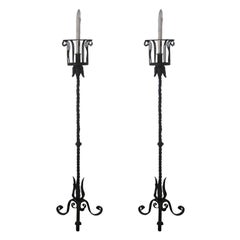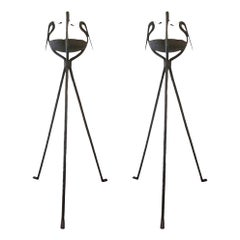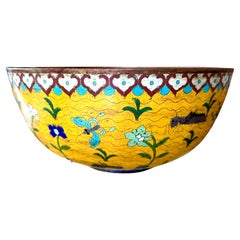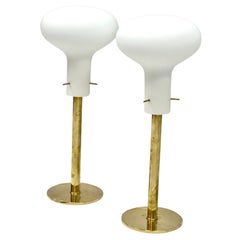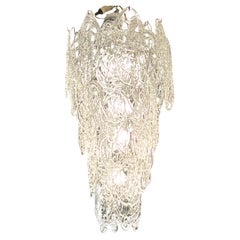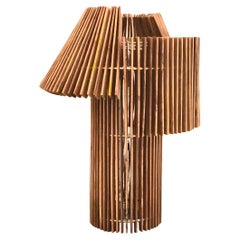Thomas Gallery Ltd
to
154
992
794
137
86
78
66
53
47
35
30
16
12
8
6
6
5
3
2
2
2
1
1
25
17
13
12
9
Pair of French Art Deco Wrought Iron Floor Lamps / Torchieres, Gilbert Poillerat
By Gilbert Poillerat
Located in New York, NY
Elegant pair of French Art Deco / Mid-Century hand-wrought iron Torchiere / standing lamps in the style of Gilbert Poillerat circa 1930-40. The floor lamps feature a tripod base, twi...
Category
Mid-20th Century French Mid-Century Modern Floor Lamps
Materials
Wrought Iron
Pair French Modern Neoclassical Wrought Iron Torchiere / Floor Lamps, Giacometti
By Alberto and Diego Giacometti
Located in New York, NY
Unique, Extraordinary Handmade Pair of French Mid-Century (1940s) Modern Neoclassical floor lamps, standing lamps or sculptures in hand-forged iron in the style of Alberto and Diego ...
Category
Vintage 1940s French Mid-Century Modern Floor Lamps
Materials
Wrought Iron
$16,750 Sale Price / set
29% Off
Chinese Export, Qing Dynasty, Qianlong, Large Decorative Cloissone Enamel Bowl
Located in New York, NY
A Chinese Export, Qing Dynasty Large Cloissone Enamel Bowl marked with the metal stamp of the Emperor Qianlong (1735-1795) on the bottom. This large and magnificent work features a ...
Category
Antique Late 18th Century Chinese Qing Decorative Bowls
Materials
Copper, Enamel
Pair of Italian Mid-Century Modern Brass Table Lamps, Max Ingrand & Fontana Arte
By Fontana Arte, Max Ingrand
Located in New York, NY
An elegant and timeless pair of Italian Mid-Century Modern table lamps attributed to Max Ingrand and Fontana Arte. The table lamps are of rare design and the highest quality of manuf...
Category
Mid-20th Century Italian Mid-Century Modern Table Lamps
Materials
Brass
2 Grand Italian Midcentury Modern Cascading Clear Murano Glass Chandeliers 1970
By AVMazzega
Located in New York, NY
2 Grand Italian Mid-Century Modern Clear Murano Glass Cascade Chandeliers and Attributed to AV Mazzega circa 1960 - 1970, Priced and Sold Individually. They are large, elegant, stunning, yet delicate Italian Venetian glass chandeliers or pendants in clear glass composed of hand made and hand blown twisted and intertwined clear loops. These exquisite pieces are refined in their neutral coloration and sublime presence . Thus, they are delightful pieces of art glass providing great light.. Dimensions: Height 47" x Diameter: 23.6". The height includes a 6" nickel pipe and canopy. Please Note: These are Priced and Sold as Individual Pieces.
Additional References: Carlo Nason Mazzega, Seguso, Barovier e Toso, Venini. Fratelli Tosi, Barbini, Venetian Glass, Hand Blown, Dale Chihuly, Art Glass, Fontana Arte, Max Ingrand, Gio Ponti...
Category
Mid-20th Century Italian Mid-Century Modern Chandeliers and Pendants
Materials
Murano Glass
'Rare 'Wood Lamp' / Art Object & Table Lamp by the Campana Brothers
By Campana Brothers
Located in New York, NY
'Wood Lamp' is an art object / table lamp by the celebrated Brazilian design duo, Fernando and Humberto Campana which exemplifies their philosophy of "transforming the everyday into ...
Category
21st Century and Contemporary Italian Modern Table Lamps
Materials
Stainless Steel
Pair of Italian Midcentury Blue-Green Glass Mirrors, Max Ingrand & Fontana Arte
By Fontana Arte, Max Ingrand
Located in New York, NY
2 Italian Hand-Crafted and Mold Blown Mid-century Modern Mirrors Attributed to Max Ingrand and Fontana Arte, Italy, circa 1960. These works of mirror art are composed of exquisite Fo...
Category
Mid-20th Century Italian Mid-Century Modern Wall Mirrors
Materials
Nickel
French Hand-Stitched, Faux Bamboo, Brown Leather Floor Lamp by Jacques Adnet
By Jacques Adnet
Located in New York, NY
An Elegant and Timeless French Mid-Century Modern Hand Stitched, Faux Bamboo, Brown Leather Floor Lamp by Jacques Adnet, France, circa 1955. This classic hand made model from the ren...
Category
Mid-20th Century French Mid-Century Modern Floor Lamps
Materials
Brass, Iron
Pair Large French Modern Neoclassical / Art Deco Iron Side Tables w. Schist Tops
By Jacques Adnet
Located in New York, NY
An Elegant and Timeless Pair of French 1930 Late Art Deco / Modern Neoclassical side or end tables. The tables offer a pure, minimal presentation with a classic context. They are top...
Category
Mid-20th Century French Art Deco End Tables
Materials
Schist, Wrought Iron
Pair of French Mid-Century Modern Gilt Iron Table Lamps attr. to Jacques Quinet
By Jacques Quinet
Located in New York, NY
Pair of French Midcentury Modern Gilt Wrought Iron Table Lamps in an Abstract Form Attributed to Jacques Quinet, France, circa 1960. An iconic pair of sculptural table lamps represen...
Category
Mid-20th Century French Mid-Century Modern Table Lamps
Materials
Wrought Iron
French Mid-Century Modern Neoclassical Wrought Iron Console by Gilbert Poillerat
By Gilbert Poillerat
Located in New York, NY
An Elegant and Timeless French Midcentury Modern Neoclassical Wrought Iron and Fossilized Limestone Console by the French master ironworker of "Les Annees 40", Gilbert Poillerat, Par...
Category
Mid-20th Century French Mid-Century Modern Console Tables
Materials
Limestone, Wrought Iron
Midcentury Partial-Gilt Wrought Iron Lounge Chairs Attributed to René Prou, Pair
By René Prou
Located in New York, NY
Elegant pair of French Mid-Century Modern Neoclassical wrought iron armchairs attributed to René Prou. The chairs are enameled black and feature a minimal transparent structure, fron...
Category
Mid-20th Century French Mid-Century Modern Lounge Chairs
Materials
Wrought Iron
French Modern Neoclassical Gilt Iron Faux Bamboo Sofa Table / Console by Baguès
By Maison Baguès
Located in New York, NY
Elegant French Mid-Century Modern Neoclassical sofa table, console, desk or vanity in gilt Iron faux bamboo by Maison Baguès. The table a timele...
Category
Mid-20th Century French Mid-Century Modern Console Tables
Materials
Marble, Wrought Iron
French Midcentury Brass and Reverse Painted Glass Console / Sofa Table, Baguès
By Maison Baguès
Located in New York, NY
A Sober and Elegant French Mid-Century Modern Neoclassical console attributed to Maison Baguès in solid brass with an inset smoked glass top partially reverse painted to form a wide ...
Category
Vintage 1960s French Mid-Century Modern Console Tables
Materials
Brass
Italian Modern Craftsman Gilt Hammered Iron Chair by Giovanni Banci for Hermes
By Hermès, Giovanni Banci
Located in New York, NY
A Rare and Unique Italian MId-Century Modern Craftsman Gilt Hammered Iron Chair by Giovanni Banci for Hermes. An iconic masterpiece, hand hammered and hand forged, by the Italian scu...
Category
Mid-20th Century Italian Mid-Century Modern Lounge Chairs
Materials
Wrought Iron
Pair of Italian MId-century Futurist Lounge Chairs Attr. to Gigi Radice, c. 1950
By Gigi Radice
Located in New York, NY
An Important Pair of Italian MId-Century Futurist Lounge Chairs Attr. to Gigi Radice. The works feature an iconic futurist form emphasizing movement and speed with their angled and a...
Category
Mid-20th Century Italian Futurist Lounge Chairs
Materials
Wrought Iron
Pair of French Hand Hammered Wrought Iron Side Tables in the style of Giacometti
By Alberto and Diego Giacometti, Jean-Michel Frank
Located in New York, NY
Exquisite and exotic pair of French Hand Hammered Wrought Iron Side Tables in the style of Alberto and Diego Giacometti for the designer and retailer, Jean-Michel Frank The pieces re...
Category
21st Century and Contemporary French Mid-Century Modern End Tables
Materials
Wrought Iron
German Mid-Century Christian Dell Bauhaus Clamp Lamp #6470 circa 1930
By Kaiser Idell, Christian Dell
Located in New York, NY
An Iconic design symbol and functional work of art: a German Mid-Century Modern / Bauhaus Clamp Lamp, Model #6470 by Christian Dell circa 1930, made for Kaiser Idell.
Additional Re...
Category
Mid-20th Century German Bauhaus Floor Lamps
Materials
Steel
Italian Modern Neoclassical 18 Century Style Venetian /Murano Glass Mirror, Tosi
By Fratelli Tosi
Located in New York, NY
Large, Elegant Italian 18th century style antiqued and etched Venetian / Murano glass mirrors with subtle coloration and dignified form. These exquisite pieces, by Fratelli Tosi, add...
Category
Late 20th Century Italian Neoclassical Wall Mirrors
Materials
Mirror
Early French Mid-Century Modern Folding Lounge Chair by Robert Mallet-Stevens
By Robert Mallet-Stevens, Pierre Dariel
Located in New York, NY
An Early French Mid-Century Modern Folding Chair by the luminary French Modernist Architect, Robert Mallet-Stevens circa 1920-1933. This iconic work of early modernism was multi-func...
Category
Vintage 1920s French Modern Lounge Chairs
Materials
Beech
Italian 18th Century Style Antiqued Venetian / Murano Glass Mirrors by Tosi
By Fratelli Tosi
Located in New York, NY
Large, Elegant Italian 18th century style antiqued and etched Venetian / Murano glass mirrors, with subtle coloration and dignified form. (2 Pieces are available and each is priced a...
Category
Late 20th Century Italian Mid-Century Modern Wall Mirrors
Materials
Mirror
Italian Modern Neoclassical Venetian Wall Mirror with Red Silk Velvet Frame
By André Arbus
Located in New York, NY
A Rare and Elegant Italian Mid-Century Modern Neoclassical Venetian in the style of Andre Arbus with a dramatic angled red silk velvet frame. The wall mirror is in large, rectangular...
Category
Mid-20th Century Italian Mid-Century Modern Wall Mirrors
Materials
Velvet, Mirror
Important French Modernist Prototype Desk & Chair by Robert Mallet-Stevens
By Robert Mallet-Stevens
Located in New York, NY
Rare handmade French early Mid-Century Modern desk and chair in hand-formed and hand-hammered (non-commercially produced) tubular steel by the visionary French modernist, Robert Mall...
Category
Vintage 1930s French Modern Desks and Writing Tables
Materials
Steel
French Mid-Century Wrought Iron Table Lamps in the Style of Giacometti
By Alberto and Diego Giacometti
Located in New York, NY
An Elegant and Timeless Pair of French Mid-Century Modern Hammered Wrought Iron Table Lamps in the Style of Alberto and Diego Giacometti, France, circa 1930 - 1950. The works are str...
Category
Mid-20th Century French Mid-Century Modern Table Lamps
Materials
Wrought Iron
French Mid-Century Style Plaster Chandelier /Pendant, style of Jean-Michel Frank
By Jean-Michel Frank
Located in New York, NY
An Elegant and Timeless French Mid-Century Modern Style Plaster Chandelier / Pendant in the style of Jean Michel Frank.
Category
Late 20th Century French Mid-Century Modern Chandeliers and Pendants
Materials
Brass
Rare French Mid-Century Solid Bronze & Leather Console, Signed by Cartier, Paris
By Jacques Quinet, Cartier
Located in New York, NY
A Rare and Elegant French Midcentury Modern Solid Bronze Console by Cartier, Paris. The piece is an exquisite minimalist classic with pure lines and form; the design is attributed to the French luminary designer, Jacques Quinet. The presentation is effortless and understated. The four legs are gently tapered and support a cantilevered top with inset Italian grained black leather. The patina is soft and subtle befitting the timeless quality of the work. Over 100 pounds of bronze were used in the casting and the piece is engraved, Cartier. Works like this are rare to find their way to the public domain for sale and this is a unique opportunity to own part of Cartier's elite history of design. Dimensions: H 29.75 x W 23.75 x D 14.75
Additional References: Hermes, Louis Vitton, Gucci, Marc du Plantier, Jacques Quinet, Emille-Jacques Ruhlmann, Jean-Michel Frank, Cartier Love Ring and Bracelet, Cartier Trinity Ring, Earrings and Bracelet, Cartier Santos Automatic Watch, Cartier Pantere Watch, Necklace, Watch and Earrings, Ballon Bleu de Cartier Watch, Baignoirie, Cartier Love Watch, Cartier Calibre Watch, Cartier Tortue Watch, Cartier Santos Chronograph...
Category
Mid-20th Century French Mid-Century Modern Console Tables
Materials
Bronze
Rare Design Mid-Century Rocking Chair / Lounge Chair Attr. to Gae Aulenti
By Gae Aulenti
Located in New York, NY
A Rare Italian MId-Century Modern Rocking Chair or Lounge Chair Attributed to Gae Aulenti. The chair is an original piece of 1960's midcentury design and possesses a strong organic m...
Category
Mid-20th Century Italian Mid-Century Modern Rocking Chairs
Materials
Steel
'Pair of Original Italian Mid-Century 'Lady' Chairs by Marco Zanuso & Arflex
By Marco Zanuso, Arflex
Located in New York, NY
A Rare Pair of Original Italian Mid-Century Modern "Lady" Chairs / Lounge Chairs / Armchairs by Marco Zanuso for Arflex, Italy, circa 1951 with original upholstery.
The chairs are s...
Category
Mid-20th Century Italian Mid-Century Modern Lounge Chairs
Materials
Brass, Steel
Pair of Italian MId-Century Aluminum & Glass Side or Coffee Tables, Fontana Arte
By Fontana Arte
Located in New York, NY
A Rare Pair of Italian MId-Century Modern Aluminum & Glass Side, End or Coffee Tables attributed to Fontana Arte from the 1935 to 1950 period. These tables go back to the early use o...
Category
Mid-20th Century Italian Mid-Century Modern End Tables
Materials
Aluminum
Italian Modern Neoclassic Gilt Iron & Crystal Consoles, Giovanni Banci & Hermes
By Giovanni Banci, Hermès
Located in New York, NY
2 Italian Mid-century Modern Neoclassical Consoles in Gilt Iron with an Inset Amber Crystal Medallion, and with Tops of Persian Travertine, by the Italian Sculptor and Designer, Giov...
Category
Mid-20th Century Italian Mid-Century Modern Console Tables
Materials
Crystal, Wrought Iron
Pair of Italian Mid-Century Modern Rattan Stools / Benches attr. Franco Albini
By Franco Albini
Located in New York, NY
Elegant Pair of Italian Mid-Century Modern Benches or Stools in Rattan attributed to Franco Albini, Italy, circa 1950. The works possess dramatic, poetic forms with the seats compos...
Category
Mid-20th Century Italian Mid-Century Modern Stools
Materials
Bamboo, Rattan
Pair of French Modern Neoclassical Crystal & Brass Table Lamps by Maison Charles
By Maison Charles
Located in New York, NY
A Rare, Elegant and Large Pair of French Midcentury Crystal and Brass Table Lamps by Maison Charles circa 1950 to 1970. They lamps reflect the Modern Neoclassical spirit with their u...
Category
Mid-20th Century French Mid-Century Modern Table Lamps
Materials
Crystal, Brass
French Midcentury Gilt Bronze Faux Bamboo & Opaline Coffee Table, Maison Bagues
By Maison Baguès
Located in New York, NY
A Sublime French Mid-Century Modern 3 Part Cocktail Table, in Gilt Bronze and Brass Faux Bamboo / Twig, with its Original Black Opaline Glass Inset Top by the renowned creator, Maiso...
Category
Mid-20th Century French Mid-Century Modern Coffee and Cocktail Tables
Materials
Brass, Bronze
Pair of Italian Mid-Century Wingback Lounge Chairs Attr. to Gio Ponti, Model 512
By Gio Ponti
Located in New York, NY
An elegant, stunning pair of Italian Mid-Century Modern armchairs or lounge or wingback or high back chairs attributed to Gio Ponti, 1955 . Gio Ponti was known for working in the Mod...
Category
Mid-20th Century Italian Mid-Century Modern Lounge Chairs
Materials
Upholstery, Hardwood
4 Unique Italian Artist Made Chairs, Campana Brothers
By Campana Brothers
Located in New York, NY
4 Individual Handmade Artist Chairs in the style of the Compana Brothers. The chairs are each uniquely composed of wood and flexibly fastened allowing movement of the individual elements to function as movable sculptures and as functional seating. Individual parts are also uniquely painted adding to the wonder and mystery of. the chairs. The 4 pieces can function as dining, desk, vanity or side chairs and are Priced and Sold as Individual pieces.
Dimensions: H 36 x W 20 x D 20.25
Additional References: Mid-Century Modern, Memphis. Ettore Sottsass, Alessandro Mendini, Studio Most, Marzo Cecchi, Studio Furniture, Art Furniture, George Nakashima, Wharton Esherick, Isamu Noguchi, Art et Industrie, Terrence Main, Frosty Myers, Richard Snyder...
Category
21st Century and Contemporary Italian Post-Modern Dining Room Chairs
Materials
Hardwood, Paint
French Mid-Century Modern Craftsman Round, Brass & Copper Mirror, Paris, 1970
By Line Vautrin
Located in New York, NY
Rare and Unique, one of a kind, hand hammered copper and brass French Modern Craftsman, Round Mirror, Paris, circa 1970. Hand signed by the artist on the rear of the mirror,
Dimensi...
Category
Mid-20th Century French Mid-Century Modern Wall Mirrors
Materials
Brass, Copper
Italian Mid-Century Brass & Stitched Faux Leather Umbrella Stand or Trash Bin.
Located in New York, NY
Elegant and original Italian Mid-Century Modern Umbrella Stand or Trash Bin. This is a functional work of art, with a classic yet modern form, made with diverse, beautiful materials....
Category
Mid-20th Century Italian Mid-Century Modern Umbrella Stands
Materials
Metal, Brass
Pair of Italian, Artist Made, Hand-Hewn Glass Sconces Attr. to Danny Lane
By FIAM, Danny Lane
Located in New York, NY
Pair of Italian artist made, hand-hewn glass sconces attributed to the artist, Danny Lane. The pieces are hand cut, in the Brutalist spirit revealing the pure nature and beauty of ...
Category
Late 20th Century Italian Modern Wall Lights and Sconces
Materials
Glass, Art Glass
Italian Midcentury Brass Articulating and Counter-Balance Desk Lamp, Arredoluce
By Arredoluce, Angelo Lelii
Located in New York, NY
Elegant and Dramatic Italian Mid-Century Modern style desk or table lamp in the style of Angelo Lelli for Arredoluce composed of a round ball black marble base anchoring a solid bras...
Category
20th Century Italian Mid-Century Modern Table Lamps
Materials
Belgian Black Marble, Metal, Brass
2 French Modern Neoclassical Rock Crystal & Iron Consoles, Jean-Michel Frank
By Jean-Michel Frank
Located in New York, NY
These pieces are priced and sold as individual pieces. 2 rare and elegant French mid-century Consoles in the Modern Neoclassical Spirit and composed of patinated wrought iron bases s...
Category
Mid-20th Century French Mid-Century Modern Console Tables
Materials
Rock Crystal, Wrought Iron
Italian Mid-Century Modern Walnut & Glass Circular Coffee Table by Gio Ponti
By Gio Ponti
Located in New York, NY
A rare and iconic Italian Mid-Century Modern Round Cocktail Table in Solid Walnut attributed to the Italian master architect and designer Gio Ponti. The piece presents an original an...
Category
Mid-20th Century Italian Mid-Century Modern Coffee and Cocktail Tables
Materials
Glass, Walnut
Italian Modern Neoclassical Brass & Green Glass Umbrella Stand by Fontana Arte
By Pier Luigi Colli, Cristal Arte, Fontana Arte
Located in New York, NY
A rare, elegant Italian Mid-Century Modern neoclassical umbrella stand in the style of Fontana Arte and attributed to Pier Luigi Colli, with glass made by Cristal Arte, circa 1960. T...
Category
Mid-20th Century Italian Mid-Century Modern Umbrella Stands
Materials
Brass
Italian Mid-Century Modern Neoclassical Walnut Sideboards attributed Paolo Buffa
By Paolo Buffa
Located in New York, NY
2 Rare, Italian Modern Neoclassical Sideboards or Buffets in Walnut with Brass Details attributed to Paolo Buffa circa 1946 - 1955. These elegant mid-century cabinets feature an exce...
Category
Mid-20th Century Italian Neoclassical Sideboards
Materials
Brass
Unique French Mid-Century Lucite Chair attributed to Maria Pergay, 1969
By Maria Pergay
Located in New York, NY
A Rare and Unique French Mid-Century Modern prototype free-form side or desk chair in lucite / plexi-glass attributed to the French artist and designer, Maria Pergay.
Documentation...
Category
Mid-20th Century French Mid-Century Modern Side Chairs
Materials
Lucite, Plexiglass
Rare French Prototype Mid-Century Coffee or End Table in Lucite, Maria Pergay
By Maria Pergay
Located in New York, NY
A Rare French Mid-Century Modern Prototype Lucite Cocktail / Coffee or End Table in the Style of Maria Pergay. The table forms an intriguing design statement with its innovative mini...
Category
Mid-20th Century French Mid-Century Modern Coffee and Cocktail Tables
Materials
Lucite, Plexiglass, Glass, Acrylic
French Mid-Century Modern Style Cantilevered Wrought Iron Floor Lamp, Disderot
By Pierre Disderot
Located in New York, NY
Elegant, sculptural French Mid-Century Modern enameled wrought iron floor lamp in the style of Disderot. The standing lamp has a stunning angled and triangulated form, elegant tapere...
Category
Mid-20th Century French Mid-Century Modern Floor Lamps
Materials
Wrought Iron
Pair of French Mid-Century Brass Faux Bamboo Floor Lamps by Maison Bagues
By Maison Baguès
Located in New York, NY
An Elegant and Timeless Pair of French Mid-Century Modern Neoclassical Floor Lamps by Maison Bagues in Solid Brass Faux Bamboo. The pieces feature a rare flattened, thick tripod base...
Category
Mid-20th Century French Mid-Century Modern Floor Lamps
Materials
Brass
Custom Pair of French Wrought Iron "Star" Floor Lamps
Located in New York, NY
An elegant and timeless pair of French, contemporary wrought iron standing lamps (1930 style) in the Etruscan taste. The Etruscan Primitive style in...
Category
Late 20th Century French Mid-Century Modern Floor Lamps
Materials
Wrought Iron
Large Italian Modern Neoclassical Carved Wood & Glass Console, Attr to G. Ulrich
By Guglielmo Ulrich
Located in New York, NY
A Rare and Exquisite Italian Midcentury console or writing table attributed to Guglielmo Ulrich, circa 1940-1950 uniting Modern, Neoclassical and Art Deco sensibilities. The console ...
Category
Mid-20th Century Italian Mid-Century Modern Console Tables
Materials
Brass
Pair, French Modern Neoclassical Brass Faux Bamboo Floor Lamps by Maison Bagues
By Maison Baguès
Located in New York, NY
Rare, Elegant and Timeless Pair of French Mid-Century Modern Neoclassical Faux Bamboo Floor Lamps in solid brass by Maison Bagues, Paris. The brass is the highest quality and the pat...
Category
Mid-20th Century French Mid-Century Modern Floor Lamps
Materials
Brass
French Mid-Century Organic Modern Terra Cotta Sculpture / Vase, Georges Jouve
By Georges Jouve
Located in New York, NY
A Rare and Elegant French Midcentury Organic Modern Sculpture / Vase or Vessel in White Terra Cotta in the style of Georges Jouve. The piece presents a daring form that is sensuous,...
Category
Mid-20th Century French Mid-Century Modern Vases
Materials
Terracotta, Paint
Rare Pair of French Art Deco Lounge Chairs in style of Jean-Michel Frank
By Jean-Michel Frank
Located in New York, NY
A Rare and Exceptional Pair of French Art Deco Armchairs / Lounge Chairs in the style of Jean MIchel Frank, circa 1930. The chairs are uniquely set in a sleek, modern, low lying squa...
Category
Mid-20th Century French Mid-Century Modern Lounge Chairs
Materials
Upholstery, Fruitwood
Set of 4 Swiss Alpine Mounted Antler & Horn Natural Specimens / Sculptures 1950
Located in New York, NY
An extraordinary collection of 4 European Mid-Century deer skulls and antler / horns mounted on hand carved wood plaques from the Swiss Alpine Regions. Each specimen is an individual...
Category
Mid-20th Century Natural Specimens
Materials
Bone, Fruitwood
Unique Minimalist Table / Floor Light by T. Thomas Gargiulo in homage Yves Klein
By Gargiulo & Thomas
Located in New York, NY
A Minimalist-Conceptual Light Sculpture functioning as a Table Lamp or Floor Lamp by T. Thomas Gargiulo. The interior of the aluminum light is enameled in Blue-Violet in Homage to th...
Category
Early 2000s American Minimalist Floor Lamps
Materials
Aluminum
Pair of Italian Mid-Century Modern / Futurist Benches Attr. to Gigi Radice
By Gigi Radice
Located in New York, NY
Rare Pair of Italian Futurist Stools / Ottomans or Benches Attributed to Gigi Radice. These original Mid-Century Modern pieces are very special in embracing the Futurist aesthetic of...
Category
Mid-20th Century Italian Mid-Century Modern Stools
Materials
Brass
Pair of Italian Mid-Century Modern Wood Benches / Stools Attributed to Gio Ponti
By Gio Ponti
Located in New York, NY
Rare pair of Italian Mid-Century Modern benches or stools attributed to Gio Ponti featuring hand cut wood side panels in a unique, organic form. These pieces are reflective of the work of Gio Ponti circa 1955 and, in particular his work at the Parco di Principe hotel. The hotel featured several pieces utilizing free form, cut-out forms which created a distinct sculptural aesthetic among the furnishings. These pieces are representative of that distinctive architectural style; they are rare and much sought after.
Gio Ponti was the most important architect and designer in Italy from the late 1920's through the entire 1950 decade and beyond. His work embraced art...
Category
Mid-20th Century Italian Mid-Century Modern Stools
Materials
Upholstery, Hardwood
French Modern Neoclassical Bench in White Simi-Leather in style of Andre Arbus
By André Arbus
Located in New York, NY
An Elegant French Midcentury Bench or Stool in the Modern Neoclassical Style with an X-frame structure. The The stool is original in its total white composition and the use of white ...
Category
Mid-20th Century French Mid-Century Modern Stools
Materials
Metal
1 French Mid-Century Modern Neoclassical Mirror Sconce / Girandole, M. Mategot
By Mathieu Matégot
Located in New York, NY
One large French modern neoclassical double arm metal wall light / sconce / girandole with mirrored backs in the style of Mathieu Mategot. The metal frame is pierced and the mirror h...
Category
Vintage 1950s French Mid-Century Modern Wall Lights and Sconces
Materials
Metal
French Mid-Century Modern Neoclassical Gilt Iron Console by Maison Ramsay
By Maison Ramsay
Located in New York, NY
An Exceptional and Important Work of French Mid-Century Modern Neoclassical Decorative Arts, this stunning and timeless console or sofa table is in hand hammered and gilt wrought iro...
Category
Mid-20th Century French Mid-Century Modern Console Tables
Materials
Travertine, Wrought Iron
French Mid-Century Modern Neoclassical Dining Table by Andre Arbus, Paris, 1949
By André Arbus
Located in New York, NY
An Elegant And Timeless French Late Art Deco / Modern Neoclassical dining room table in Cherry wood by Andre Arbus. The table without leaves is 72" ...
Category
Vintage 1940s French Mid-Century Modern Dining Room Tables
Materials
Brass
